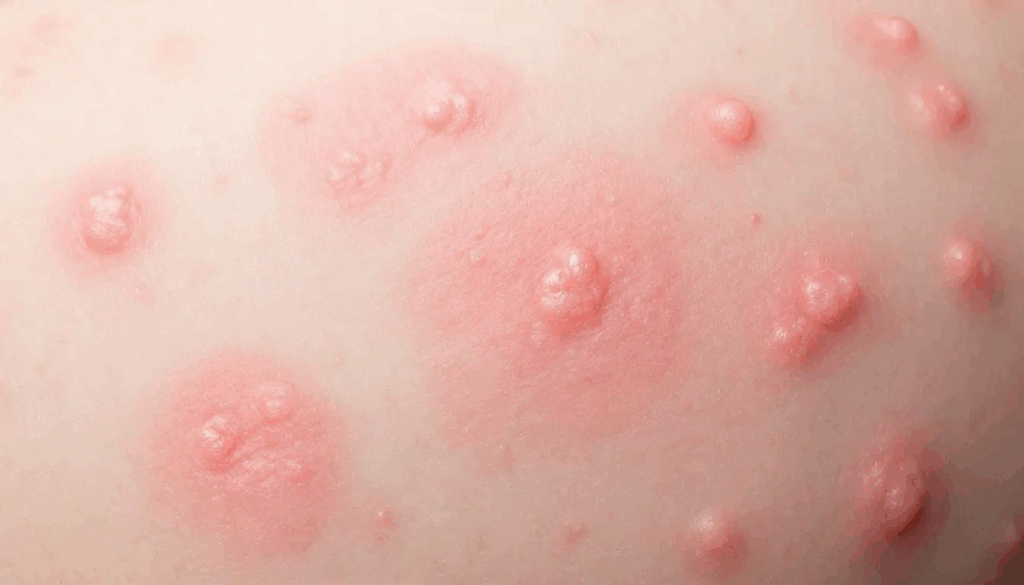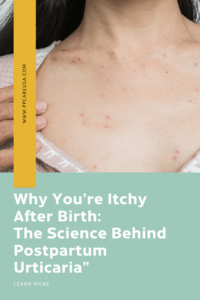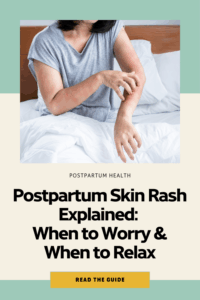Skin conditions are among the most common concerns new mothers face. While you may expect certain postpartum skin changes like stretch marks or loose skin, the sudden appearance of dry skin and itchy, raised bumps can be alarming. Postpartum urticaria, commonly known as postpartum hives, affects a small but significant number of women after giving birth.
Understanding this condition, its causes, and safe treatment options can help you navigate this challenging time with confidence. This comprehensive guide covers everything you need to know about postpartum urticaria, from recognizing symptoms to finding relief while maintaining your overall health and caring for your new baby.

What Is Postpartum Urticaria?
Postpartum urticaria is a skin condition characterized by the development of itchy, raised welts or hives that appear after childbirth (Source). These skin issues manifest as red, pink, or skin-colored bumps that can vary in size and may appear anywhere on the body. The condition is part of the broader spectrum of postpartum skin changes that many women experience due to hormonal fluctuations and immune system adjustments.
While general urticaria is relatively common, postpartum urticaria specifically affects approximately 1-3% of new mothers, making it a relatively uncommon but impactful condition. The rash typically develops within the first few weeks after delivery, though it can occasionally appear months later as hormone levels continue to stabilize.
Postpartum urticaria differs significantly from other postpartum skin conditions. Unlike postpartum acne, which primarily affects the face and is related to sebaceous glands and excess sebum production, urticaria can appear anywhere on the postpartum skin. It’s also distinct from conditions like melasma or dark patches that some women develop during pregnancy, as urticaria involves raised, itchy bumps rather than pigmentation changes.
The condition is sometimes associated with PUPPP (Pruritic Urticarial Papules and Plaques of Pregnancy), a skin condition that typically begins in the third trimester but can continue or even start after delivery. However, postpartum urticaria can also occur independently, triggered by the unique circumstances of the postpartum recovery period.
Postpartum Urticaria Symptoms
Recognizing the symptoms of postpartum urticaria is crucial for proper management and treatment. The condition presents with several characteristic features that distinguish it from other skin concerns during the postpartum period.
The primary symptom is the appearance of red, raised, itchy bumps or welts on the skin. These hives may vary in size from small, mosquito bite-like bumps to larger plaques several inches across. The itchy skin often becomes the most distressing aspect of the condition, with intensity that can significantly impact sleep and daily activities.

One distinctive feature of postpartum hives is their transient nature – individual bumps may appear and disappear within hours, only to reappear in different locations. This migratory pattern is characteristic of urticaria and helps differentiate it from other skin conditions that remain fixed in one area.
The itching associated with postpartum urticaria tends to be most intense at night, which can compound the sleep challenges already faced by new mothers. Some women also experience burning or stinging sensations on the affected skin, particularly when the area is touched or rubbed.
Common locations for postpartum urticaria include the abdomen, thighs, buttocks, and arms, though the condition can affect any part of the body. The skin’s texture in affected areas may feel rough or bumpy, and the surrounding skin might appear slightly swollen or inflamed.
In some cases, women may experience angioedema – deeper swelling that typically affects areas around the eyes, lips, hands, or feet. This swelling can be more concerning as it involves deeper tissue layers and may require more immediate medical attention.
What Causes Postpartum Urticaria?
Understanding the causes of postpartum urticaria helps in both prevention and treatment. The condition results from a complex interplay of factors unique to the postpartum period, making new mothers particularly susceptible during this time.
Hormonal fluctuations represent the primary trigger for postpartum urticaria. After giving birth, hormone levels undergo dramatic changes as the body transitions from pregnancy to the postpartum state. The rapid decline in estrogen and progesterone levels can disrupt immune regulation and skin homeostasis, leading to increased sensitivity and inflammatory responses.
These hormonal shifts affect the immune system significantly. During pregnancy, the maternal immune system adapts to tolerate the developing baby, but after delivery, it must readjust to its pre-pregnancy state. This transition period can result in heightened immune reactivity, making the skin more prone to allergic reactions and inflammatory conditions like urticaria.
Stress from sleep deprivation and the overwhelming responsibilities of new motherhood plays a substantial role in triggering postpartum skin issues. The combination of physical recovery from childbirth, interrupted sleep patterns, and emotional adjustments can compromise the immune system and exacerbate skin conditions.
For some women, postpartum urticaria may be a continuation of PUPPP syndrome that began during pregnancy. PUPPP typically starts in the third trimester and can persist after delivery, though it usually resolves within a few weeks postpartum.
Allergic reactions to new medications, foods, or skincare products introduced during the postpartum period can also trigger urticaria. Pain medications, antibiotics, or new topical treatments used during postpartum recovery may act as allergens in sensitive individuals.
The physical effects of pregnancy itself – skin stretching, healing tissues, and ongoing recovery – can create inflammatory responses that contribute to urticaria development. Blood vessels that were dilated during pregnancy may remain sensitive, and the healing process can trigger immune responses that manifest as hives.
How Long Does Postpartum Urticaria Last?
The duration of postpartum urticaria varies significantly among women, but understanding typical timelines can help set realistic expectations for recovery. Most cases are acute and resolve within a relatively short period, though individual experiences may differ based on underlying causes and treatment approaches.
In typical cases, postpartum urticaria lasts anywhere from a few days to several weeks postpartum. The majority of women see improvement within the first month after onset, particularly when appropriate treatment measures are implemented and triggering factors are identified and avoided.
For cases related to PUPPP syndrome, the urticaria usually resolves within 15 days after delivery as hormone levels begin to stabilize. However, women who develop urticaria independent of PUPPP may experience a more variable timeline, with some cases persisting for several weeks or even months.
The recovery timeline depends heavily on hormonal stabilization, which can take several months as the body adjusts to its new postpartum state. Breastfeeding may influence the duration due to continued hormonal changes, particularly elevated prolactin levels that can affect immune function and skin sensitivity.
Chronic cases, where urticaria persists for more than six weeks, are relatively uncommon but may occur if underlying causes aren’t properly addressed. These cases often require more comprehensive evaluation to identify specific triggers or underlying health conditions that may be contributing to the persistent symptoms.
Stress management and overall self-care play crucial roles in determining how quickly the condition resolves. Women who can manage stress effectively, maintain adequate sleep (when possible), and follow appropriate treatment protocols typically experience faster recovery times.
Postpartum Urticaria Treatment
Effective treatment of postpartum urticaria focuses on safe options that won’t interfere with breastfeeding while providing meaningful symptom relief. The approach typically combines topical treatments, oral medications when necessary, and lifestyle modifications to support healing.
Antihistamines form the cornerstone of urticaria treatment and are generally safe for breastfeeding mothers. Loratadine and cetirizine are considered first-line options due to their excellent safety profiles and minimal transfer into breast milk. These medications can provide significant relief from itching and help prevent new hives from forming.
Topical corticosteroids prescribed by healthcare providers can offer localized relief for particularly troublesome areas. Low to mid-potency formulations are typically recommended for short-term use and are considered compatible with breastfeeding when used as directed.
Cool compresses provide immediate, drug-free relief for itchy bumps and inflamed skin. Applying cold packs wrapped in soft cloth for 10-15 minutes several times daily can help reduce inflammation and numb the itching sensation.
Oatmeal baths offer soothing relief for widespread urticaria. Colloidal oatmeal has natural anti-inflammatory properties that can calm irritated skin and provide temporary relief from
itching. Adding finely ground oatmeal to lukewarm bath water creates a gentle, therapeutic soak.
Avoiding known triggers becomes crucial for preventing flare-ups. This includes using gentle cleansers instead of harsh soaps, avoiding hot showers that can exacerbate symptoms, and managing stress through relaxation techniques when possible.
Gentle, fragrance-free moisturizers help support the skin barrier and can prevent secondary irritation. Look for products specifically formulated for sensitive skin and apply them while the skin is still slightly damp to lock in moisture.
For severe cases that don’t respond to first-line treatments, healthcare providers may consider prescription medications. However, any systemic treatments require careful evaluation of the risk-benefit ratio, particularly for breastfeeding mothers.
Safe Skincare Routine During Breastfeeding
Navigating skincare while breastfeeding requires careful consideration of product safety and application methods. Understanding which topical treatments are safe and how to use them properly ensures effective treatment without compromising infant safety.
Breastfeeding-safe topical treatments include most over-the-counter antihistamine creams and mild topical corticosteroids when used as directed. The key is applying these treatments to clean skin and allowing adequate time for absorption before potential skin-to-skin contact with your baby.
Several ingredients should be avoided or used with caution during breastfeeding. Topical products containing high concentrations of salicylic acid, benzoyl peroxide, or retinoids may not be suitable for nursing mothers, particularly if applied to large areas of skin.
Natural remedies like aloe vera and chamomile can provide gentle, soothing relief without safety concerns. Pure aloe vera gel offers cooling, anti-inflammatory benefits, while chamomile-based creams or compresses can help calm irritated skin naturally.
Before using any new topical products, consulting with healthcare providers ensures safety and appropriateness for your specific situation. This is particularly important for prescription treatments or products containing active ingredients that may have systemic absorption.
As a precautionary measure, wiping treatment areas before baby contact can provide additional peace of mind, especially when using medicated creams or ointments. This simple step ensures minimal potential for accidental ingestion or skin contact.
When selecting skincare products during the postpartum period, choose gentle cleansers and fragrance-free moisturizers that support skin barrier function without causing additional irritation. A consistent, simple skincare routine often works better than complex regimens during this sensitive time.
When to Seek Medical Help for Postpartum Skin Changes
While postpartum urticaria is typically manageable at home, certain warning signs indicate the need for immediate medical attention. Recognizing these red flags ensures appropriate care and prevents potentially serious complications.
Difficulty breathing, chest tightness, or wheezing accompanying urticaria may indicate anaphylaxis, a serious allergic reaction requiring emergency medical care. Facial swelling, particularly around the eyes, lips, or tongue, also warrants immediate evaluation as it can affect breathing and swallowing.
Persistent hives lasting more than six weeks postpartum suggest chronic urticaria, which may require specialist evaluation to identify underlying causes. Chronic cases often need more comprehensive testing and different treatment approaches than acute episodes.
Fever accompanying urticaria outbreaks can indicate an underlying infection or more serious systemic condition. While mild body aches and fatigue are common with urticaria, significant fever requires medical evaluation to rule out other causes.
Rapidly spreading hives or those covering large body areas may indicate a severe allergic reaction or systemic condition requiring professional assessment. Similarly, hives accompanied by other symptoms like joint pain, nausea, or significant malaise warrant medical attention.
The impact on sleep, daily activities, or mental health should not be underestimated. Severe itching that prevents adequate rest or significantly affects quality of life justifies medical consultation for more effective treatment options.
Healthcare providers may want to rule out conditions like postpartum thyroiditis, which can sometimes present with skin symptoms alongside other systemic effects. Blood tests may be recommended if urticaria is accompanied by other unexplained symptoms.
Will My Skin Return to Normal After Postpartum Urticaria?
The outlook for postpartum urticaria is overwhelmingly positive, with most women experiencing complete resolution of symptoms and return to normal skin health. Understanding the recovery process and timeline can provide reassurance during what can be a stressful experience.
Most postpartum urticaria resolves completely with proper care and time. The skin typically returns to its normal appearance without lasting marks or changes once the condition resolves. Unlike some other skin conditions, urticaria rarely leaves permanent scarring or pigmentation changes.
The timeline for skin recovery generally follows hormonal stabilization, which typically occurs within 6-12 months postpartum. As hormone levels return to pre-pregnancy ranges and the immune system rebalances, the tendency toward urticaria episodes diminishes significantly.
Long-term skin health strategies can help prevent future outbreaks and maintain healthy skin throughout the postpartum period and beyond. This includes maintaining a healthy diet rich in anti-inflammatory foods, staying adequately hydrated, and using gentle skincare products that support skin barrier function.
Stress management and self-care play crucial roles in both recovery and prevention. Finding ways to manage the challenges of new motherhood, whether through support networks, relaxation techniques, or adequate rest when possible, benefits overall health and skin condition.
Proper treatment during the acute phase helps prevent scarring and long-term skin issues. Following healthcare provider recommendations, avoiding excessive scratching, and maintaining good skin hygiene all contribute to optimal healing and recovery.
Building confidence during the healing process is an important aspect of recovery. Understanding that postpartum urticaria is temporary and treatable can help reduce anxiety and stress, which in turn supports faster healing and better overall outcomes.
Many women find that their skin becomes more resilient after recovery, and future pregnancies don’t necessarily result in recurrent urticaria. Each pregnancy and postpartum period is unique, and having experienced urticaria once doesn’t guarantee it will happen again.
Getting Answers for Your Post Pregnancy Skin Changes
The key to successful recovery lies in patience, appropriate treatment, and maintaining realistic expectations about the healing timeline. With proper care and support, most women can expect their skin to return to normal function and appearance, allowing them to focus on enjoying their time with their new baby and adjusting to life as a new mother.
For mothers concerned about their recovery or experiencing persistent symptoms, maintaining open communication with healthcare providers ensures optimal outcomes and peace of mind throughout the healing process. Remember that seeking help is a sign of good self-care, not weakness, and appropriate treatment can significantly improve both comfort and recovery time.
Pin This for Later:



Postnatal Depletion
Meet the Team
Our Services
Supplements
A virtual healthcare clinic that helps postpartum mamas recover from postnatal depletion syndrome with a holistic approach.

Get in touch